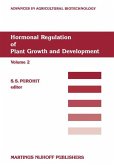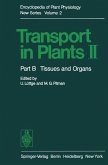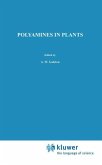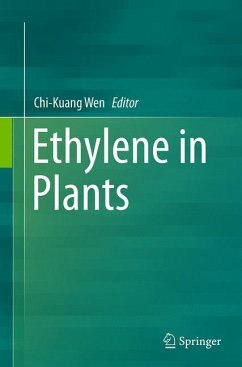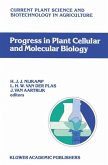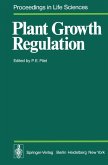Ethylene
Biochemical, Physiological and Applied Aspects, An International Symposium, Oiryat Anavim, Israel held January 9¿12 1984
Herausgegeben:Fuchs, Y.; Chalutz, E.
Ethylene
Biochemical, Physiological and Applied Aspects, An International Symposium, Oiryat Anavim, Israel held January 9¿12 1984
Herausgegeben:Fuchs, Y.; Chalutz, E.
- Broschiertes Buch
- Merkliste
- Auf die Merkliste
- Bewerten Bewerten
- Teilen
- Produkt teilen
- Produkterinnerung
- Produkterinnerung
An International Symposium, Qiryat Anavim, Israel, January 9-12, 1984
Andere Kunden interessierten sich auch für
![Fundamental, Ecological and Agricultural Aspects of Nitrogen Metabolism in Higher Plants Fundamental, Ecological and Agricultural Aspects of Nitrogen Metabolism in Higher Plants]() Fundamental, Ecological and Agricultural Aspects of Nitrogen Metabolism in Higher Plants229,99 €
Fundamental, Ecological and Agricultural Aspects of Nitrogen Metabolism in Higher Plants229,99 €![Hormonal Regulation of Plant Growth and Development Hormonal Regulation of Plant Growth and Development]() Hormonal Regulation of Plant Growth and Development115,99 €
Hormonal Regulation of Plant Growth and Development115,99 €![Transport in Plants II Transport in Plants II]() Transport in Plants II77,99 €
Transport in Plants II77,99 €![Polyamines in Plants Polyamines in Plants]() Polyamines in Plants153,99 €
Polyamines in Plants153,99 €![Ethylene in Plants Ethylene in Plants]() Ethylene in Plants75,99 €
Ethylene in Plants75,99 €![Progress in Plant Cellular and Molecular Biology Progress in Plant Cellular and Molecular Biology]() Progress in Plant Cellular and Molecular Biology153,99 €
Progress in Plant Cellular and Molecular Biology153,99 €![Plant Growth Regulation Plant Growth Regulation]() Plant Growth Regulation123,99 €
Plant Growth Regulation123,99 €-
-
-
An International Symposium, Qiryat Anavim, Israel, January 9-12, 1984
Hinweis: Dieser Artikel kann nur an eine deutsche Lieferadresse ausgeliefert werden.
Hinweis: Dieser Artikel kann nur an eine deutsche Lieferadresse ausgeliefert werden.
Produktdetails
- Produktdetails
- Advances in Agricultural Biotechnology 9
- Verlag: Springer / Springer Netherlands
- Artikelnr. des Verlages: 978-94-009-6180-7
- Softcover reprint of the original 1st ed. 1984
- Seitenzahl: 372
- Erscheinungstermin: 12. Oktober 2011
- Englisch
- Abmessung: 235mm x 155mm x 21mm
- Gewicht: 563g
- ISBN-13: 9789400961807
- ISBN-10: 9400961804
- Artikelnr.: 39492227
- Herstellerkennzeichnung Die Herstellerinformationen sind derzeit nicht verfügbar.
- Advances in Agricultural Biotechnology 9
- Verlag: Springer / Springer Netherlands
- Artikelnr. des Verlages: 978-94-009-6180-7
- Softcover reprint of the original 1st ed. 1984
- Seitenzahl: 372
- Erscheinungstermin: 12. Oktober 2011
- Englisch
- Abmessung: 235mm x 155mm x 21mm
- Gewicht: 563g
- ISBN-13: 9789400961807
- ISBN-10: 9400961804
- Artikelnr.: 39492227
- Herstellerkennzeichnung Die Herstellerinformationen sind derzeit nicht verfügbar.
A. Ethylene Biosynthesis and Mode of Action.- 1. The formation of ethylene from 1-aminocyclopropane-1-caboxylic acid.- 2. The biochemistry and physiology of 1-aminocyclopropane-1-carboxylic acid conjugation.- 3. Model systems for the formation of ethylene from 1-amino-cyclopropane-1-carboxylic acid.- 4. Occurrence of membrane-bound enzyme catalyzing the formation of ethylene from 1-aminocyclopropane-1-carboxylic acid from carnation plants.- 5. Distribution and properties of ethylene-binding from plant tissue.- 6. Binding sites for ethylene.- 7. Why do plants metabolize ethylene?.- 8. Role of ethylene oxidation in the mechanism of ethylene action.- 9. Superinduction of ACC synthase in tomato pericarp by lithium ions.- 10. 1-aminocyclopropane-1-carboxylic acid (ACC)-dependent ethylene synthesis in vacuoles of pea and bean leaves.- 11. ACC conversion to ethylene by mitochondria from etiolated pea (Pisum sativum) seedlings.- 12. Wound-induced ethylene production and its control in the mesocarp tissue of winter squash fruit.- 13. Characterization of the carbohydrates-stimulated ethylene production in tobacco leaf discs.- 14. Role of sucrose in the metabolism of IAA-conjugates as related to ethylene production by tobacco leaf discs.- 15. The effect of cycloalkenes on ethylene binding.- B. Ethylene in Development and Senescence.- 16. Ethylene and flower senescence.- 17. On ethylene, calcium and oxidative mediation of whole apple fruit senescence by core control.- 18. Ethylene-mediated growth response in submerged deep-water rice.- 19. Control of the biosynthesis of ethylene in senescing tissues.- 20. Wound-induced increase in 1-aminocyclopropane-1-carboxy-late synthase activity: regulatory aspects and membrane association of the enzyme.- 21. Reduced S-adenosylmethionine decarboxylase activity in ethylene-treated etiolated pea seedlings.- 22. 1-aminocyclopropane-1-carboxylic acid (ACC) and ethylene production during senescence of oat leaf segments.- 23. Effect of naturally produced ethylene in tissue culture jars.- 24. Involvement of ethylene in Liatris corm dormancy.- 25. Endogenous ethylene production and flowering of Bromeliaceae.- 26. Role of ethylene in distribution of assimilates in carnations.- 27. Characterization of an endogenous inhibitor of ethylene biosynthesis in carnation petals.- C. Ethylene in Stress and Disease.- 28. Regulation of pathogenesis and symptom expression in diseased plants by ethylene.- 29. Ethylene biosynthesis in tobacco leaf discs in relation to ethylene treatment, Cellulysin application and fungal infection.- 30. Purification and properties of the ethylene-inducing factor from the cell wall digesting mixture, Cellulysin.- 31. The involvement of callose and elicitors in ethylene production caused by mechanical perturbation.- 32. Elicitors and ethylene trigger defense response in plants.- 33. The role of ethylene in the pathogenic symptoms by Meloidogyne javanica nematode-infected tomato plants.- D. Ethylene in the Control of Abscission.- 34. Abscission and recognition of zone specific target cells.- 35. Is ethylene the natural regulator of abscission?.- 36. Anatomical aspects of citrus abscission - effect of ethylene on leaf and fruit explants.- 37. Ethephon action in growth and abscission control.- 38. Effect of ethylene on indol-3-acetic acid transport, metabolism and level in leaf tissues of woody plants during abscission.- 39. Effects of the defoliant thidiauzuron on leaf abscission and ethylene evolution from cotton seedlings.- 40. Ethylene and auxin transport and metabolism in peach fruit abscission.-E. Ethylene in Fruit Ripening and Storage.- 41. Ethylene and the control of tomato fruit ripening.- 42. Experiments to prevent ethylene biosynthesis and/or action and effect of exogenous ethylene on ripening and storage of apple fruit.- 43. Possible role of fruit cell wall oxidative activity in ethylene evolution.- 44. Compartmentation of amino acids in tomato fruit pericarp tissue.- 45. Effect of salinity on the ripening process in tomato fruit: possible role of ethylene.- 46. Effect of mannose on ethylene evolution and ripening of pear fruit.- F. Participants.- G. Index.
A. Ethylene Biosynthesis and Mode of Action.- 1. The formation of ethylene from 1-aminocyclopropane-1-caboxylic acid.- 2. The biochemistry and physiology of 1-aminocyclopropane-1-carboxylic acid conjugation.- 3. Model systems for the formation of ethylene from 1-amino-cyclopropane-1-carboxylic acid.- 4. Occurrence of membrane-bound enzyme catalyzing the formation of ethylene from 1-aminocyclopropane-1-carboxylic acid from carnation plants.- 5. Distribution and properties of ethylene-binding from plant tissue.- 6. Binding sites for ethylene.- 7. Why do plants metabolize ethylene?.- 8. Role of ethylene oxidation in the mechanism of ethylene action.- 9. Superinduction of ACC synthase in tomato pericarp by lithium ions.- 10. 1-aminocyclopropane-1-carboxylic acid (ACC)-dependent ethylene synthesis in vacuoles of pea and bean leaves.- 11. ACC conversion to ethylene by mitochondria from etiolated pea (Pisum sativum) seedlings.- 12. Wound-induced ethylene production and its control in the mesocarp tissue of winter squash fruit.- 13. Characterization of the carbohydrates-stimulated ethylene production in tobacco leaf discs.- 14. Role of sucrose in the metabolism of IAA-conjugates as related to ethylene production by tobacco leaf discs.- 15. The effect of cycloalkenes on ethylene binding.- B. Ethylene in Development and Senescence.- 16. Ethylene and flower senescence.- 17. On ethylene, calcium and oxidative mediation of whole apple fruit senescence by core control.- 18. Ethylene-mediated growth response in submerged deep-water rice.- 19. Control of the biosynthesis of ethylene in senescing tissues.- 20. Wound-induced increase in 1-aminocyclopropane-1-carboxy-late synthase activity: regulatory aspects and membrane association of the enzyme.- 21. Reduced S-adenosylmethionine decarboxylase activity in ethylene-treated etiolated pea seedlings.- 22. 1-aminocyclopropane-1-carboxylic acid (ACC) and ethylene production during senescence of oat leaf segments.- 23. Effect of naturally produced ethylene in tissue culture jars.- 24. Involvement of ethylene in Liatris corm dormancy.- 25. Endogenous ethylene production and flowering of Bromeliaceae.- 26. Role of ethylene in distribution of assimilates in carnations.- 27. Characterization of an endogenous inhibitor of ethylene biosynthesis in carnation petals.- C. Ethylene in Stress and Disease.- 28. Regulation of pathogenesis and symptom expression in diseased plants by ethylene.- 29. Ethylene biosynthesis in tobacco leaf discs in relation to ethylene treatment, Cellulysin application and fungal infection.- 30. Purification and properties of the ethylene-inducing factor from the cell wall digesting mixture, Cellulysin.- 31. The involvement of callose and elicitors in ethylene production caused by mechanical perturbation.- 32. Elicitors and ethylene trigger defense response in plants.- 33. The role of ethylene in the pathogenic symptoms by Meloidogyne javanica nematode-infected tomato plants.- D. Ethylene in the Control of Abscission.- 34. Abscission and recognition of zone specific target cells.- 35. Is ethylene the natural regulator of abscission?.- 36. Anatomical aspects of citrus abscission - effect of ethylene on leaf and fruit explants.- 37. Ethephon action in growth and abscission control.- 38. Effect of ethylene on indol-3-acetic acid transport, metabolism and level in leaf tissues of woody plants during abscission.- 39. Effects of the defoliant thidiauzuron on leaf abscission and ethylene evolution from cotton seedlings.- 40. Ethylene and auxin transport and metabolism in peach fruit abscission.-E. Ethylene in Fruit Ripening and Storage.- 41. Ethylene and the control of tomato fruit ripening.- 42. Experiments to prevent ethylene biosynthesis and/or action and effect of exogenous ethylene on ripening and storage of apple fruit.- 43. Possible role of fruit cell wall oxidative activity in ethylene evolution.- 44. Compartmentation of amino acids in tomato fruit pericarp tissue.- 45. Effect of salinity on the ripening process in tomato fruit: possible role of ethylene.- 46. Effect of mannose on ethylene evolution and ripening of pear fruit.- F. Participants.- G. Index.




